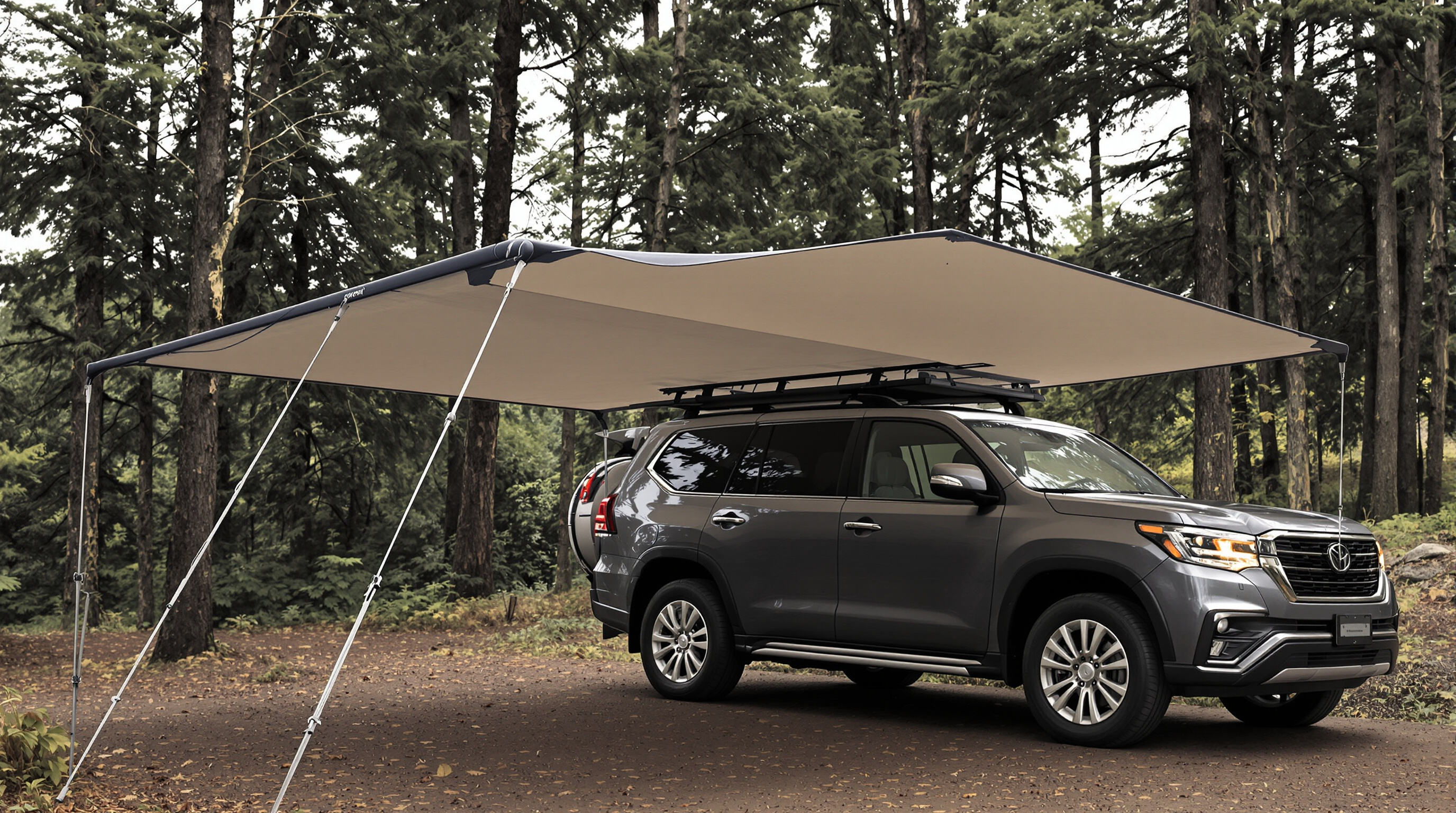Car Shade Tents vs. Permanent Structures
Understanding Car Shade Tents: Portability, Design, and Performance
What Are Car Shade Tents and How Do They Support Outdoor Mobility?
Car shade tents serve as portable covers that keep cars safe from harsh weather conditions like sunlight, rain showers, and flying dirt particles while still allowing folks to move around outside without hassle. There are basically three main kinds available on the market today. First up we have those rooftop mounted options which let people sleep higher off the ground when camping out overnight. Then there's the hatchback extension type that turns part of the vehicle into something between inside space and outside area depending on what needs arise during a trip. And finally there are freestanding versions similar to small carports that provide shelter just about anywhere someone parks their vehicle temporarily. What makes these different from regular fixed structures is how fast they go up and work well across all sorts of landscapes including rough mountain trails or soft sand at beach locations where traditional shelters would struggle to stay put.
Ease of Setup and Portability for Vehicle-Based Campers
Modern car shade tents simplify setup, with most models requiring under 10 minutes for assembly. Lightweight aluminum poles and pre-attached guylines reduce bulk, while integrated storage bags ensure compact transport. Rooftop tents often feature hydraulic mechanisms that deploy shelters in seconds—ideal for adventurers arriving at campsites after dark.
Material Quality, Durability, and Weather Resistance
The best quality car shade tents are typically made from either 280D poly-cotton blends or PU coated polyester fabric. These materials provide strong UV protection (rated at UPF 50+) and can handle heavy rain thanks to their 3,000mm waterproof rating. According to the latest Outdoor Gear Report from 2024, most campers seem to agree with this assessment since around three quarters of respondents said good materials were absolutely necessary when dealing with winds that blow over 30 miles per hour. Still worth noting though, nothing really compares to those fixed steel frame shelters which tend to last well beyond ten years before needing replacement.
Real-World Performance and Limitations in Harsh Conditions
Car shade tents work pretty well when temperatures are mild, but they struggle when weather gets really harsh. A recent survey from 2023 found that about two thirds of people using them during desert storms had trouble keeping their freestanding units stable without adding extra weight like sandbags or tying them to vehicles. When it comes to snow, anything over four inches sitting on top can be dangerous for standard models since their roofs tend to collapse under pressure. For this reason, most experts suggest these tents are best kept for short term projects or seasonal events rather than year round protection needs.
Vehicle-Mounted Awnings: Retractable Shade Solutions for On-the-Go Living

Function and Lifestyle Benefits of Retractable Car Awnings
Car awnings that can be retracted offer both tough construction and flexibility when needed, which is why they work so well for people who love exploring off-road trails, spend time at the beach, or just enjoy long drives across country. These aren't like those traditional shade tents where everything has to be put together piece by piece. Most models pop out quickly thanks to spring loaded struts or simple push rod extensions. When deployed, they turn ordinary parking areas into comfortable shaded spaces great for quick meals between stops, keeping equipment organized during travel, or shielding from sudden rain showers. Field testing last year showed most users were happy with their retractable setups, around 92 percent actually. They mentioned things like cooler interior temperatures inside cars and better protection against harmful sun rays for delicate items stored inside.
Installation and Compatibility with Vehicle Setups
Retractable awnings typically come with universal mounting brackets that work well with most roof racks, truck beds, and camper shells. The better quality ones have these handy quick release clamps so no drilling is needed which makes them great for people who rent places or own multiple vehicles. When it comes to weight limits, they generally handle between 45 to about 90 pounds based on what materials were used in construction. Aluminum frames tend to offer the best balance between strength and how much they weigh. Getting these installed correctly matters a lot because it determines whether they'll work properly with rooftop tents and stop problems when driving faster than around 28 miles per hour in windy conditions.
Integration with Rooftop Tents and 270-Degree Expandable Designs
Some clever setups now merge retractable awnings with rooftop tents using these new modular mounting systems. The newest models with those 270 degree designs were actually nominated for something called the Outdoor Gear Innovation Award in 2024. They provide this great shaded area around kitchens or where people sit together. Add on an annex room and suddenly there's about 110 square feet of living space that works no matter what the weather does. That's pretty much like having a small permanent structure, yet everything packs down into just a 20 inch case that mounts right onto vehicles. What makes this combo so smart is how it cuts down on the overall space needed at campsites without sacrificing the ability to hit the road whenever someone wants.
Permanent Shade Structures: Long-Term Value and Design Considerations
Defining Permanent Shade Solutions in Residential and Recreational Settings
Shade structures meant to stay put forever are pretty common around residential areas, campsites, and businesses alike. They're different from those portable car awnings we all know because they include things like metal frame gazebos, tensioned shade sails, and cantilever models that don't move once installed. According to research published last year in an outdoor construction journal, nearly four out of five recreational sites with fixed shade cover noticed their cars and patio furniture lasted longer during hot seasons than when using temporary options. What makes these permanent installations so great? Well, they blend right into the surrounding environment while offering solid sun protection against almost all UV radiation. Plus, real estate experts have pointed out time and again that properly installed shade structures can actually boost property values over time.
Durability, Weather Resistance, and Maintenance Requirements
HDPE mesh and powder coated steel have become go to materials for many installations because they last around 15 to 20 years even in tough weather conditions. Permanent installations handle much stronger winds than temporary solutions can manage. When correctly put in place, these structures survive gusts reaching 85 miles per hour according to tests done during simulated coastal storms published in the Outdoor Engineering Journal back in 2022. But there is some upkeep needed throughout the seasons. People need to check those anchor points regularly, make sure no junk gets stuck in the tensioned fabric areas, and apply fresh corrosion protection coatings somewhere between three to five years after installation depending on local conditions.
Environmental and Regulatory Constraints on Fixed Installations
Most local zoning rules set strict limits on how tall permanent shade structures can be, usually around 12 to 15 feet high, plus they require certain setbacks from property boundaries. When building in areas where wildfires are common, the materials used need to pass these tough Class A fire tests, which drives up costs anywhere from 20% to 35%. And let's not forget about environmental impact assessments either. Nearly half the states across America (that's 43%) demand these assessments when installing anything close to protected ecosystems. This extra paperwork tends to slow things down quite a bit, sometimes stretching out projects by as much as four to eight weeks longer than planned.
Car Shade Tents vs. Permanent Structures: Matching Use Case to Optimal Design
When to Choose Portable Shade: Camping, Overlanding, and Temporary Use
Car shade tents are great when people need something set up fast and want to move around easily. Campers who hit the road more than 500 miles each month love these because they have light aluminum frames paired with fabric that blocks most UV rays. Putting one together takes less than ten minutes and stops about 95% of harmful sun exposure. When dealing with rough ground conditions, these portable options beat fixed structures hands down. A lot of outdoor enthusiasts actually prefer collapsible models since they can fit right into their roof racks. The fact that these aren't permanent helps protect nature too. According to the National Park Service from last year, around 83 percent of temporary shelters don't leave any mess behind once taken down. That makes these tents perfect for national parks and other sensitive wild areas where leaving nothing behind matters.
When Permanent Structures Make Sense: Backyard, Commercial, or Frequent Use
For places that get at least five people using them each month or need shade all year round, fixed shade structures tend to be much cheaper in the long run. These structures typically have galvanized steel frames covered with polyethylene mesh that can handle wind speeds over 55 miles per hour as tested by ASTM standards back in 2023. When it comes to surviving those harsh seasonal storms, these permanent setups beat portable tents hands down. The numbers tell the story too something like 42 percent savings over time when businesses don't have to keep buying new portable units every couple of years as found in recent research on shading material lifecycles from 2024. Plus most local governments across America accept these fixed installations under their zoning rules about 9 out of 10 times, giving business owners peace of mind knowing they won't run into legal issues while needing consistent overhead protection.
FAQ
What types of car shade tents are available?
Car shade tents are available in three main types: rooftop-mounted, hatchback extensions, and freestanding versions. Each serves different outdoor needs and offers portability and ease of setup.
Are car shade tents suitable for all weather conditions?
Car shade tents work well in mild weather but struggle in extreme conditions. They may become unstable in high winds or heavy snow, requiring additions like sandbags for stability.
What are the benefits of retractable vehicle awnings?
Retractable vehicle awnings offer flexible shade solutions. They are easily deployable, provide UV protection, and can be set up in seconds, making them ideal for off-road and outdoor activities.
When are permanent shade structures more advantageous?
Permanent shade structures are more advantageous for places needing long-term shade or around-the-year use, such as backyards or commercial spaces. They offer better durability and long-term cost savings.

